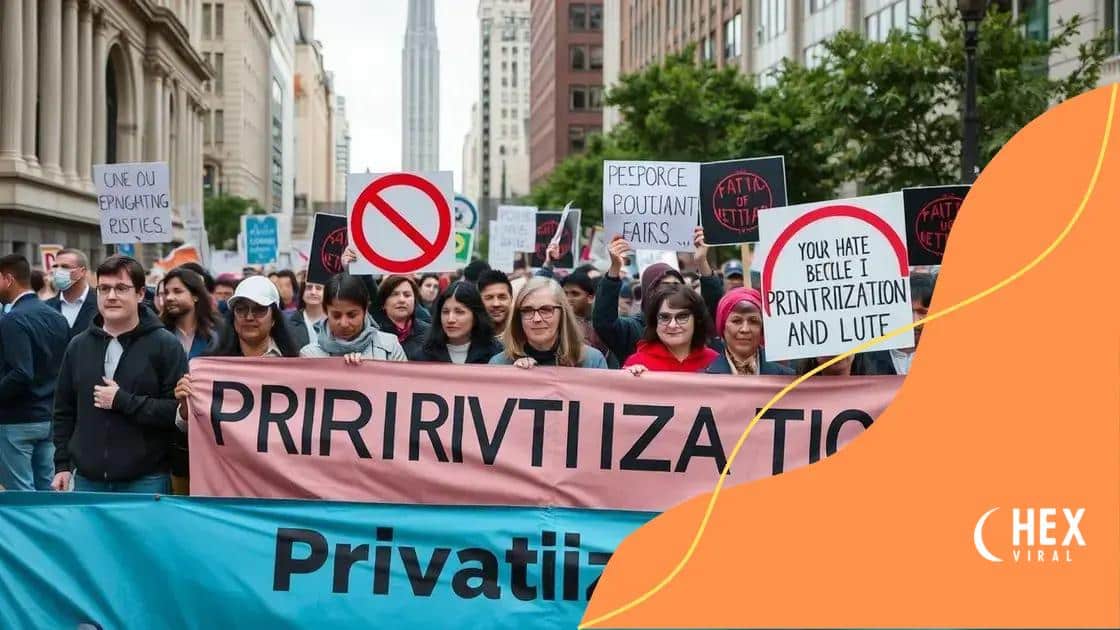Anti-privatization protests in public sectors: what you should know

Anti-privatization protests arise from community concerns over service quality and accessibility, urging the preservation of public control over essential services to prevent inequalities fostered by privatization efforts.
Anti-privatization protests in public sectors have become a significant phenomenon, driven by communities voicing their concerns over how vital services are managed. Ever wondered how these movements affect the quality of life in cities? Let’s explore this important topic.
Understanding the motivations behind protests
Understanding the motivations behind anti-privatization protests is crucial to grasp the ongoing social movements. These protests stem from public concerns over maintaining control of essential services and ensuring accessibility for all.
Economic Concerns
One of the main drivers of these protests is the economic impact of privatization on everyday individuals. Communities fear that privatizing essential services will lead to increased costs. This concern is not unfounded, as past privatizations have often resulted in higher prices and reduced service quality.
- Rising costs affecting low-income families
- Job losses in public sectors
- Reduced access to essential services in rural areas
Another important factor is the belief that government services should remain under public oversight. Many protestors argue that public sectors are more accountable to the people they serve compared to private companies, whose primary goal is profit.
Social Justice Elements
Social justice also plays a key role in motivating protests. Many community members feel that privatization disproportionately affects marginalized groups. They view these movements as a fight for equity and social responsibility.
- Impact on healthcare access for vulnerable populations
- Education accessibility issues among low-income families
- Environmental concerns related to privatized resources
Ultimately, understanding these motivations helps paint a clearer picture of why communities are vocal against privatization. Protesters are not just opposing change; they are advocating for a fair system that prioritizes the needs of all citizens.
Key examples of recent anti-privatization movements
Key examples of recent anti-privatization movements highlight the widespread public concern about privatizing essential services. These protests have arisen globally, illustrating diverse aspects of community resistance.
Water and Sanitation Services
In several countries, communities have mobilized against the privatization of water and sanitation services. For instance, protests in Bolivia gained international attention when citizens demanded access to affordable clean water. The privatization efforts led to exorbitant price hikes, igniting public outrage.
- Bolivia: Protests in Cochabamba to oppose water privatization
- South Africa: Pushback against the privatization of municipal water supply
- India: Demonstrations against privatizing public sanitation facilities
Furthermore, these movements often emphasize the importance of public ownership. Many activists believe that access to clean water is a human right. When profit motives come into play, it jeopardizes the essential needs of the community.
Healthcare Systems
Another critical area of activism is healthcare. In the United States, numerous protests have erupted in response to proposals to privatize public health services. Activists argue that privatization leads to inequities in access to vital healthcare, especially for low-income populations.
- Public outcry against rising healthcare costs in California
- Campaigns in the UK focusing on the privatization of the National Health Service (NHS)
- Grassroots efforts in Canada defending public health coverage
Recent mobilizations also underscore the potential deterioration of service quality. Many participants in these movements express concern that privatized healthcare systems often prioritize profit over patient care.
The role of social media in organizing protests

The role of social media in organizing protests has become increasingly significant in recent years. Activists leverage platforms like Twitter, Facebook, and Instagram to mobilize support and spread awareness about anti-privatization movements.
Instant Communication
Social media enables instant communication among activists. It allows people to rapidly share information about events, updates, and changes in plans. For example, when a protest location changes last minute, activists can quickly alert followers, ensuring good participation.
- Real-time updates on protest locations
- Immediate sharing of news and developments
- Quick organization of spontaneous gatherings
This speed of communication helps build a strong sense of community and shared purpose among participants. People feel connected and engaged, which, in turn, fuels their commitment to the cause.
Creating Awareness
Beyond just communication, social media plays a crucial role in raising awareness. Activists use hashtags to share their messages, making them easily searchable and accessible. This strategy can amplify their reach far beyond local communities.
- Hashtags like #NoPrivatization increase visibility
- Viral videos and posts educate the public
- Influencers can rally support and generate interest
Moreover, compelling visual content provides powerful storytelling. A compelling image or video can instantly convey the urgency of a situation, driving people to participate. Through social media, organizations can share impactful stories that highlight the personal consequences of privatization, encouraging more empathy and participation.
Impact on public services and community perceptions
The impact of anti-privatization protests on public services and community perceptions is profound. These movements often reflect deep-seated concerns over the quality and accessibility of essential services.
Quality of Services
Protests generally arise when communities fear that privatization will lead to a decline in service quality. For example, when public transportation is privatized, there is often a perception that profit motives overshadow passenger needs. This can result in reduced reliability and increased fares.
- Fear of reduced maintenance and infrastructure investment
- Concerns over the reliability of services
- Risk of laying off skilled workers in favor of cheaper labor
As a result, communities rally to emphasize the value of maintaining public control over such sectors. They believe public services should prioritize citizen needs rather than corporate profit.
Community Perceptions
The protests also significantly influence how communities view their local governments. When communities see a government allowing privatization, it may lead to distrust and feelings of abandonment. Residents may feel their concerns are ignored and that their voices do not matter.
- Increased community activism and engagement
- Perception of government as unresponsive or indifferent
- Heightened discussions about social justice and equity
Through these movements, communities often come together, fostering solidarity and collaboration. This collective identity can lead to increased civic engagement, compelling local leaders to be more responsive to public demands. Ultimately, these protests shape both the immediate quality of services and long-term relationships between citizens and their government.
Comparison with privatization successes
Comparison with privatization successes provides insight into different outcomes of privatization efforts. While many protests center on negative impacts, there are instances where privatization has led to improvements in services.
Success Stories in Privatization
Some countries have seen success after privatizing certain industries. For example, in the telecommunications sector, privatization has often resulted in increased competition and lower prices for consumers. This trend highlights that privatization can sometimes drive efficiency.
- Telecommunications in the UK: Enhanced service options and reduced costs
- Airline industries: Competition leading to cheaper fares
- Electricity markets: Lower prices through competition
These successes show that privatization can lead to positive changes, but not without challenges and risks for public sectors. Proponents argue that when properly regulated, privatization can unlock innovation and encourage better services.
Challenges to Consider
Despite these successes, it’s crucial to analyze the challenges faced. In many cases, privatization has led to service inequalities, particularly for low-income populations. For instance, while some areas may enjoy improved services, others face stark declines.
- Disparities in service quality based on geography
- Profit-driven motives undermining public interests
- Risks of monopolies arising from deregulation
The mixed results of privatization underscore the need for careful consideration when approaching public sector changes. While some sectors may flourish post-privatization, others can suffer significantly, highlighting the importance of finding a balanced approach.
In conclusion, the ongoing anti-privatization protests reveal a complex interplay between community concerns and the potential benefits of privatization. While there are success stories demonstrating improvements in certain sectors, the risks of inequality and reduced access to essential services cannot be ignored. It is essential for communities to stay informed and engaged, advocating for a balanced approach that considers both public needs and the lessons learned from privatization experiences. Ultimately, fostering dialogue and collaboration can help create a better future for public services that serve everyone effectively.
FAQ – Frequently Asked Questions about Anti-Privatization Protests
What are anti-privatization protests?
Anti-privatization protests are public demonstrations against the privatization of essential services, aimed at preserving public control and access.
What motivates communities to protest against privatization?
Communities are often motivated by concerns over service quality, accessibility, and the belief that essential services should remain publicly controlled.
Can privatization ever lead to positive outcomes?
Yes, there are cases where privatization has improved efficiency and service quality, but these successes need to be balanced with potential risks of inequality.
How does social media influence anti-privatization movements?
Social media serves as a platform for organizing protests, spreading awareness, and fostering community engagement, enabling rapid communication and outreach.






